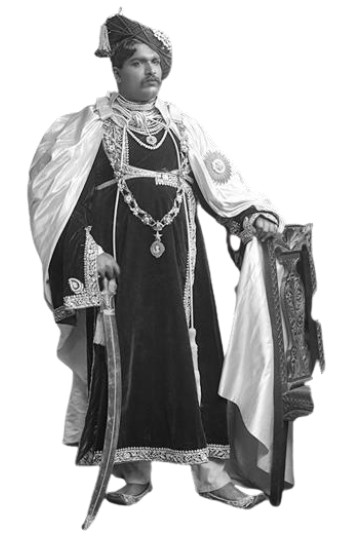The Ghatge family of Kagal province was a well-known family among the courtiers of Adilshaha. In this family, on 26 June 1874, a son was born to the ruler of this family, Jayasinghrao a.k.a Abasaheb Ghatge and Radhabai. That boy was named ‘Yashwantrao.’ He later gained fame in history as Rajarshi Shahu Maharaj. At that time, Narayan Rao from the house of Savardekar-Bhosale was ascending the throne of Kolhapur as the fourth Shivaji Chhatrapati. But he passed away at a very young age due to some reason. Due to this, the throne of Chhatrapati was left empty without an heir. British Governors had passed strict rules for the adoption of Indian rulers. But Shahu Maharaj’s family were close relatives of Chhatrapati’s throne; the British allowed Yashwantrao to be adopted. Rani Anandibai, the wife of the fourth Shivaji Maharaj, duly adopted Yashwantrao on 17 March 1884. In this way, Yashwantrao of the Ghatge family of Kagal became ‘Shahu Chhatrapati’ and sat on the throne of Kolhapur.

Shahu Maharaj’s early education took place under the supervision of this British officer, Fitzgerald. Along with his studies, he also gained proficiency in sports like shooting, wrestling, and equitation. After occupying the throne of Chhatrapati, he made his first public appearance at the program, where he laid the foundation stone of the Kolhapur-Miraj Railway. After the death of Chhatrapati Shahu Maharaj’s father, his father’s friend William Lee-Warner appointed the British I.C. S. officer, Stuart Mitford Fraser, as his teacher. Under Fraser’s supervision, Shahu Maharaj planned a 5000-mile tour for administrative supervision. Shahu Maharaj’s idea behind planning this tour was to find out the condition of his country’s people and to understand the socio-religious situation. Shahu Maharaj took over the reins of the state on 2 April 1894. ‘The royalty given to me is not for the enjoyment of royalty and royal luxury; it has been received only for the salvation of those who are poor, backward, ignored people.’ Such was the belief of Shahu Maharaj.
The progress achieved in sports, education, and the social sector in Kolhapur during the tenure of Maharaj was very commendable. Maharaj’s priority was to uplift the backward classes, and he motivated them to get educated for their redemption. Maharaj helped many capable students by providing financial assistance. Giving shape to his dreams, he gave many scholarships and opened many hostels. At that time, Maharaj also took the revolutionary decision to give 50% reservation to the backward classes in government jobs.
The social conditions at that time were such that it was impossible for students of all castes, especially the so-called untouchables and upper castes, to live, eat etc., in one place. Rajashri Shahu Maharaj needed to spread education, especially among the backward castes, so they had to start hostels for different castes in an emergency. This benefited many backward castes and created a favorable education environment. Not only this, but everyone should get the opportunity to study; that is why Maharaj made primary education free and compulsory. And also ensured financial punishment to the parents who did not send their children to school alone. Only certain castes have no right over the study of Vedas, rather, to give the message that Vedas belong to all, Shahu Maharaj started Ved Pathshala, and it was kept open for students of all castes. From this, indeed, the inheritance does not come from the ancestors or the father, but the inheritance is obtained from one’s merit and hard work.
Maharaj always encouraged the scheduled caste people to become financially independent. Apart from giving them financial help, he also gave them moral support. He visited a Harijan’s restaurant every day and drank tea; he taught society the spirit of ‘unity.’ He also went a step ahead for the Harijans and opened the gates of the Royal Palace. In the royal marriage of the princess (eldest daughter of the Maharaj), the Maharaja allowed the Harijans with an open heart, and the responsibility of welcoming the procession was entrusted to the Harijans.
In a letter sent to Chhatrapati Shahu Maharaj, Dr. Ambedkar writes that,
“My dear Maharaj Saheb,
We need you ever so much for you are the pillar of that great movement towards social democracy which is making its headway in India.
Riya Pardeshi (riya.pardeshi@ssfoffice.in)
REFERENCES:
- Lokraja Shahu Maharaj : Vyaktitva aani Vichar
- https://www.culturalindia.net/reformers/shahu-chhatrapati.html
- https://www.india.com/lifestyle/chhatrapati-shahu-maharaj-5-things-to-know-about-the-great-king-and-reformer-4768683/
- https://timesofindia.indiatimes.com/city/kolhapur/Rare-photos-letters-to-offer-a-glimpse-into-Rajarshi-Shahu-Maharajs-life/articleshow/47807999.cms
- https://countercurrents.org/2017/01/bahujan-revolutionary-king-chhatrapati-shahu-maharaj/
- Samajkrantikarak Rajarshi Shahu Chhatrapati, By Dr. Jayshinghrao Pawar https://books.google.co.in/books?id=qjM7EAAAQBAJ&printsec=frontcover&source=gbs_ge_summary_r&cad=0#v=onepage&q&f=false
